EVENTS
Home

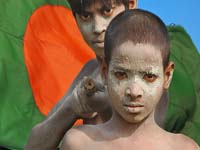
President: Zillur Rahman (2009)
Prime Minister: Sheikh Hasina (2009)
Land area: 51,703 sq mi (133,911 sq km); total area: 55,598 sq mi (144,000 sq km)
Population: 161,083,804 (July 2012 est.), Growth rate: 1.579% (2012 est), Birth rate: 22.53 births/1,000 population (2012 est.), Infant mortality rate: 5.71 deaths/1,000 population (July 2012 est.), Life expectancy: male: 68.21 years (2012 est.), female: 71.98 years (2012 est.), Density: 1,146 per sq km.
Prime Minister: Sheikh Hasina (2009)
Land area: 51,703 sq mi (133,911 sq km); total area: 55,598 sq mi (144,000 sq km)
Population: 161,083,804 (July 2012 est.), Growth rate: 1.579% (2012 est), Birth rate: 22.53 births/1,000 population (2012 est.), Infant mortality rate: 5.71 deaths/1,000 population (July 2012 est.), Life expectancy: male: 68.21 years (2012 est.), female: 71.98 years (2012 est.), Density: 1,146 per sq km.
Capital and largest city (2003 est.): Dhaka, 12,560,000 (metro.area), 5,378,023 (city proper)
Other large cities: Chittagong, 2,592,400; Khulna, 1,211,500
Monetary unit: Taka
Principal languages: Bangla (official), English
Ethnicity/race: Bengali 98%, tribal groups, non-Bengali Muslims (1998)
Religions: Islam 83%, Hindu 16%, other 1% (1998)
National Holiday: Independence Day, March 26
Economic summary: GDP/PPP (2009 est.): $242.4 billion; per capita $1,600. Real growth rate: 5.6%. Inflation: 5.1%. Unemployment: 2.5% (includes underemployment). Arable land: 55.39%. Agriculture: rice, jute, tea, wheat, sugarcane, potatoes, tobacco, pulses, oilseeds, spices, fruit; beef, milk, poultry. Labor force: 66.6 million; note: extensive export of labor to Saudi Arabia, Kuwait, UAE, Oman, Qatar, and Malaysia; agriculture 63%, industry 11%, services 26% (FY95/96). Industries: cotton textiles, jute, garments, tea processing, paper newsprint, cement, chemical fertilizer, light engineering, sugar. Natural resources: natural gas, arable land, timber, coal. Exports: $15.9 billion (2009 est.): garments, jute and jute goods, leather, frozen fish and seafood (2001). Imports: $20.2 billion (2009 est.): machinery and equipment, chemicals, iron and steel, textiles, foodstuffs, petroleum products, cement (2000). Major trading partners: U.S., Germany, UK, France,Italy,India,China, Singapore, Kuwait, Japan, Hong Kong (2004).
Other large cities: Chittagong, 2,592,400; Khulna, 1,211,500
Monetary unit: Taka
Principal languages: Bangla (official), English
Ethnicity/race: Bengali 98%, tribal groups, non-Bengali Muslims (1998)
Religions: Islam 83%, Hindu 16%, other 1% (1998)
National Holiday: Independence Day, March 26
Economic summary: GDP/PPP (2009 est.): $242.4 billion; per capita $1,600. Real growth rate: 5.6%. Inflation: 5.1%. Unemployment: 2.5% (includes underemployment). Arable land: 55.39%. Agriculture: rice, jute, tea, wheat, sugarcane, potatoes, tobacco, pulses, oilseeds, spices, fruit; beef, milk, poultry. Labor force: 66.6 million; note: extensive export of labor to Saudi Arabia, Kuwait, UAE, Oman, Qatar, and Malaysia; agriculture 63%, industry 11%, services 26% (FY95/96). Industries: cotton textiles, jute, garments, tea processing, paper newsprint, cement, chemical fertilizer, light engineering, sugar. Natural resources: natural gas, arable land, timber, coal. Exports: $15.9 billion (2009 est.): garments, jute and jute goods, leather, frozen fish and seafood (2001). Imports: $20.2 billion (2009 est.): machinery and equipment, chemicals, iron and steel, textiles, foodstuffs, petroleum products, cement (2000). Major trading partners: U.S., Germany, UK, France,Italy,India,China, Singapore, Kuwait, Japan, Hong Kong (2004).
Nationality: Bangladeshi
Languages: Bangla (official, also known as Bengali), English
Religions: Muslim 89.5%, Hindu 9.6%, other 0.9%
Sex ratio:
at birth: 1.04 male(s)/female
under 15 years: 1.03 male(s)/female
15-64 years: 0.9 male(s)/female
65 years and over: 0.96 male(s)/female
total population: 0.95 male(s)/female (2012 est.)
Languages: Bangla (official, also known as Bengali), English
Religions: Muslim 89.5%, Hindu 9.6%, other 0.9%
Sex ratio:
at birth: 1.04 male(s)/female
under 15 years: 1.03 male(s)/female
15-64 years: 0.9 male(s)/female
65 years and over: 0.96 male(s)/female
total population: 0.95 male(s)/female (2012 est.)
Amar Bangladesh (amarbd.net) is a platform where you will get quick information about Bangladesh. You can give free advertise to buy/sell your product in here, its very simple to do it. Free bangla mp3 songs can be great company for you when you are in online. Some tips (life style) have been added which are really useful in our daily life and also you can enjoy with funny games.
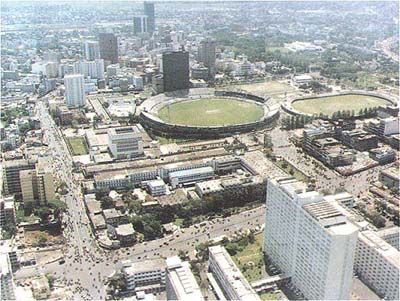
Geography : Bangladesh is a low-lying, riparian country located in South Asia with a largely marshy jungle coastline of 710 kilometers (440 mi.) on the northern littoral of the Bay of Bengal. Formed by a deltaic plain at the confluence of the Ganges (Padma), Brahmaputra (Jamuna), and Meghna Rivers and their tributaries, Bangladesh's alluvial soil is highly fertile but vulnerable to flood and drought. Hills rise above the plain only in the Chittagong Hill Tracts in the far southeast and the Sylhet division in the northeast. Straddling the Tropic of Cancer, Bangladesh has a subtropical monsoonal climate characterized by heavy seasonal rainfall, moderately warm temperatures, and high humidity. Natural calamities, such as floods, tropical cyclones, tornadoes, and tidal bores affect the country almost every year. Bangladesh also is affected by major cyclones on average 16 times a decade.
Urbanization is proceeding rapidly, and it is estimated that only 30% of the population entering the labor force in the future will be absorbed into agriculture, although many will likely find other kinds of work in rural areas. The areas around Dhaka and Comilla are the most densely settled. The Sundarbans, an area of coastal tropical jungle in the southwest and last wild home of the Bengal tiger, and the Chittagong Hill Tracts on the southeastern border with Burma and India, are the least densely populated.
Urbanization is proceeding rapidly, and it is estimated that only 30% of the population entering the labor force in the future will be absorbed into agriculture, although many will likely find other kinds of work in rural areas. The areas around Dhaka and Comilla are the most densely settled. The Sundarbans, an area of coastal tropical jungle in the southwest and last wild home of the Bengal tiger, and the Chittagong Hill Tracts on the southeastern border with Burma and India, are the least densely populated.
Agriculture : Most Bangladeshis earn their living from agriculture. Although rice and jute are the primary crops, maize and vegetables are assuming greater importance. Due to the expansion of irrigation networks, some wheat producers have switched to cultivation of maize which is used mostly as poultry feed. Tea is grown in the northeast. Because of Bangladesh's fertile soil and normally ample water supply, rice can be grown and harvested three times a year in many areas. Due to a number of factors, Bangladesh's labor-intensive agriculture has achieved steady increases in food grain production despite the often unfavorable weather conditions. These include better flood control and irrigation, a generally more efficient use of fertilizers, and the establishment of better distribution and rural credit networks.
Economy : Although one of the world's poorest and most densely populated countries, Bangladesh has made major strides to meet the food needs of its increasing population, through increased domestic production augmented by imports. The land is devoted mainly to rice and jute cultivation, although wheat production has increased in recent years; the country is largely self-sufficient in rice production. Nonetheless, an estimated 10% to 15% of the population faces serious nutritional risk. Bangladesh's predominantly agricultural economy depends heavily on an erratic monsoonal cycle, with periodic flooding and drought. Although improving, infrastructure to support transportation, communications, and power supply is poorly developed. Bangladesh is limited in its reserves of coal and oil, and its industrial base is weak. The country's main endowments include its vast human resource base, rich agricultural land, relatively abundant water, and substantial reserves of natural gas.
Economy : Although one of the world's poorest and most densely populated countries, Bangladesh has made major strides to meet the food needs of its increasing population, through increased domestic production augmented by imports. The land is devoted mainly to rice and jute cultivation, although wheat production has increased in recent years; the country is largely self-sufficient in rice production. Nonetheless, an estimated 10% to 15% of the population faces serious nutritional risk. Bangladesh's predominantly agricultural economy depends heavily on an erratic monsoonal cycle, with periodic flooding and drought. Although improving, infrastructure to support transportation, communications, and power supply is poorly developed. Bangladesh is limited in its reserves of coal and oil, and its industrial base is weak. The country's main endowments include its vast human resource base, rich agricultural land, relatively abundant water, and substantial reserves of natural gas.
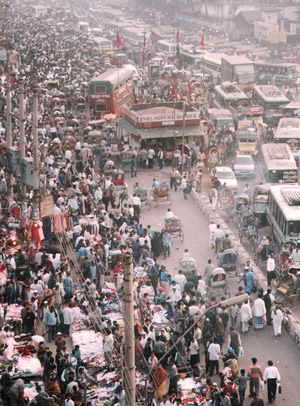
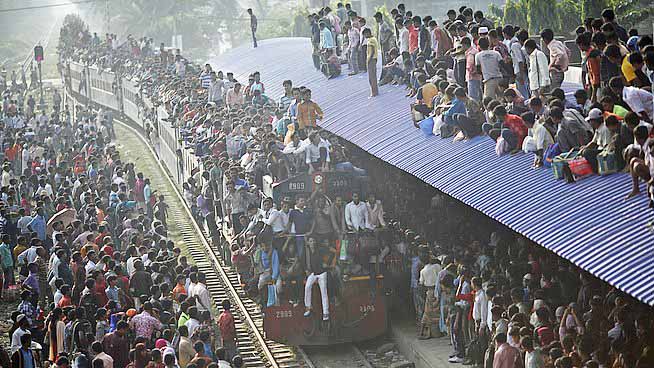
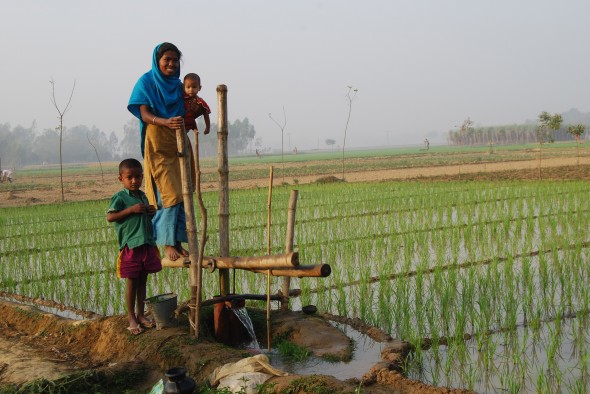
Six Seasons in Bangladesh
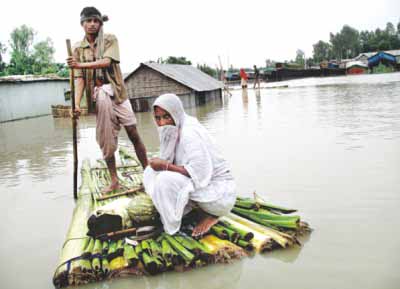
70 percent of the land is under water In Bangladesh, water from rivers, the sea, rain, tidal waves, floods and the melting snows of the Himalayas. The rains are at first a welcome relief from the baking, dusty hot season. But as the rains continue, the land turns into a brown and watery mass, ever-changing in shape and texture. Fields and homes are flooded; people and animals have to move to higher ground. Food is reduced to pre-cooked rice, dal and jackfruit that ripen at this time. During the rains, most villages are isolated, accessible only by boat. Children leap naked into ponds. Women swim in sarees. Men dive in wearing sarongs. It is during the rainy season that Bangladesh’s main crop, jute, begins to ripen and is harvested. Farmers dive down to the roots to cut them. The stalks are placed on high ground to dry. Aside from the practical problems, the rains and water also inspire the poetry, art and songs of the people.
(September to October) Autumn
As September begins, the skies are blue and a cool wind blows. The land turns into a carpet of bright green rice shoots while the smell of drying jute invades the air. Flowers bloom, the rice ripens and the harvest begins. Blue, gold and green are the colours of sarat – blue sky, golden sun and green vegetation from emerald to jade, pea to lime, shamrock to sea-green. In the green fields, white Siberian cranes, egrets and ducks hunt for food. Although the air is humid, there is a slight chill late at night.
(October to November) Late autumn
Once the land has emerged from its watery grave, it is time to replant in new, fertile soil that is rich in nutrients. During this season, the land is at its luscious best. Festivals flourish to hail the harvest, the end of the floods, the coming of the new soil and the wonder of the rivers. The country’s troubadours are everywhere, dressed in bright clothes and singing for money. The land and its people come to life during hemanto, when the flowers bloom – jasmine, water lily, rose, magnolia, hibiscus and bougainvillea. By the season’s end, the air is no longer humid. Fresh scents replace the dry jute smell.
(November to December) Winter
From mid-November to early January, the weather becomes more arid and less humid. The earth dries and dust forms. Warm clothes are pulled out. Young people play tennis, football, cricket and golf. Seet is also the season when people return to their ancestral villages, where they can experience once again the essence of Bangladesh – the harmony of man, beast, land, water and air.
(December to February) Spring
The coolest days are from mid-December to February when the days are golden with light, the flowers are blooming and the nights and early mornings are chilly. Night guards wrap themselves up in shawls and blankets with scarves and hats pulled down over their ears. During basanto, the countryside hums with fairs, parades and commemorations. Arts festivals celebrate painting and handicrafts, poetry, music and drama. In Dhaka, basanto heralds the beginning of the social season with a frantic whirl of invitations to weddings, parties and dinners. Along with the cool weather comes the nation’s silly season – politics. To a Bangladeshi, politics is what alcohol or sport is to other nations. Everyone gets involved.
(March to May) Summer
Throughout basanto, the weather warms up a bit each day until March 1, when the heat starts intensifying more rapidly. The soil turns a dusty khaki and then almost white. There are lightening and thunder storms and sometimes, icy lumps of hail crash down. The rivers dry out and are difficult to navigate. Grisma is also the peak time for the brick industry. Bricks are used for building and are a substitute for stone and gravel in Bangladesh. In the cities, the humid air is laden with dust, brick grit and auto fumes. The sun is a round red globe, beating down relentlessly.
(September to October) Autumn
As September begins, the skies are blue and a cool wind blows. The land turns into a carpet of bright green rice shoots while the smell of drying jute invades the air. Flowers bloom, the rice ripens and the harvest begins. Blue, gold and green are the colours of sarat – blue sky, golden sun and green vegetation from emerald to jade, pea to lime, shamrock to sea-green. In the green fields, white Siberian cranes, egrets and ducks hunt for food. Although the air is humid, there is a slight chill late at night.
(October to November) Late autumn
Once the land has emerged from its watery grave, it is time to replant in new, fertile soil that is rich in nutrients. During this season, the land is at its luscious best. Festivals flourish to hail the harvest, the end of the floods, the coming of the new soil and the wonder of the rivers. The country’s troubadours are everywhere, dressed in bright clothes and singing for money. The land and its people come to life during hemanto, when the flowers bloom – jasmine, water lily, rose, magnolia, hibiscus and bougainvillea. By the season’s end, the air is no longer humid. Fresh scents replace the dry jute smell.
(November to December) Winter
From mid-November to early January, the weather becomes more arid and less humid. The earth dries and dust forms. Warm clothes are pulled out. Young people play tennis, football, cricket and golf. Seet is also the season when people return to their ancestral villages, where they can experience once again the essence of Bangladesh – the harmony of man, beast, land, water and air.
(December to February) Spring
The coolest days are from mid-December to February when the days are golden with light, the flowers are blooming and the nights and early mornings are chilly. Night guards wrap themselves up in shawls and blankets with scarves and hats pulled down over their ears. During basanto, the countryside hums with fairs, parades and commemorations. Arts festivals celebrate painting and handicrafts, poetry, music and drama. In Dhaka, basanto heralds the beginning of the social season with a frantic whirl of invitations to weddings, parties and dinners. Along with the cool weather comes the nation’s silly season – politics. To a Bangladeshi, politics is what alcohol or sport is to other nations. Everyone gets involved.
(March to May) Summer
Throughout basanto, the weather warms up a bit each day until March 1, when the heat starts intensifying more rapidly. The soil turns a dusty khaki and then almost white. There are lightening and thunder storms and sometimes, icy lumps of hail crash down. The rivers dry out and are difficult to navigate. Grisma is also the peak time for the brick industry. Bricks are used for building and are a substitute for stone and gravel in Bangladesh. In the cities, the humid air is laden with dust, brick grit and auto fumes. The sun is a round red globe, beating down relentlessly.